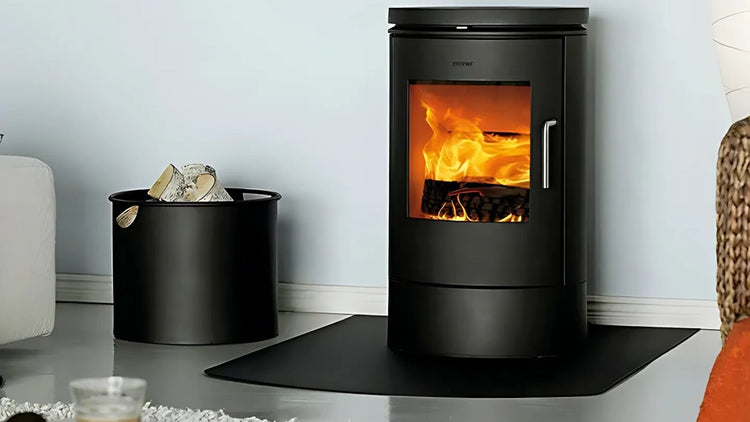
Can I Install a Wood Burning Stove Without a Chimney?
Wood burning stoves are increasingly popular thanks to their ability to create a warm, inviting atmosphere while also offering a practical heating solution. But what if your home doesn’t have a chimney? Whether you live in a modern property or a converted space without a traditional fireplace, you might be wondering: Can I install a wood burning stove without a chimney?
The answer is yes, you absolutely can. A chimney is not a requirement for installing a wood burning stove, but you will need an alternative system to safely vent smoke and gases out of your home. This is usually achieved through a twin wall flue system, which serves the same function as a chimney, even if your house doesn’t have one.
Let’s take a look at how it works, what your options are, and what you should consider before installing a stove in a chimney-less property.
Understanding the Role of a Chimney or Flue
A chimney isn’t just a charming architectural feature, it plays a crucial safety and performance role. When a stove burns wood, it produces smoke and other combustion gases. These need to be vented outside the home quickly and efficiently to avoid smoke buildup and dangerous gases like carbon monoxide.
This is where a flue comes in. A flue is essentially a controlled pathway that draws air through the stove and expels gases upward and out. In homes with a chimney, a flue liner is usually installed inside the chimney to guide these gases safely out. In homes without a chimney, the flue needs to be constructed from scratch, usually by installing a twin wall flue system.
What Is a Twin Wall Flue System?
A twin wall flue system is a specially designed metal pipe system that can be installed both internally or externally to safely carry combustion gases from the stove to the outside of your home.
As the name suggests, these flue pipes consist of two layers, an inner pipe that carries the smoke, and an outer pipe that prevents the heat from transferring to nearby walls or surfaces. The space between the layers is insulated to maintain high temperatures in the flue, which helps with efficient smoke draw and reduces condensation.
The flue can run:
-
Vertically through your home, passing through ceilings and out of the roof
-
Externally up an outside wall, exiting through the wall behind the stove and traveling upward along the building’s exterior
In both cases, the flue must terminate above the roof line to ensure proper draw and dispersion of smoke.
Where Can You Install a Stove Without a Chimney?
Without the constraints of a chimney, you actually have greater flexibility in terms of stove placement. You can install a wood burner in rooms where you might not expect one, like kitchens, extensions, conservatories, or even cabins and garden offices.
That said, there are still important rules and considerations to follow:
-
The flue system must comply with Building Regulations (in the UK, this falls under Document J)
-
The stove must be placed on a non-combustible hearth
-
Minimum distances must be observed between the stove/flue and nearby combustible materials
-
Ventilation requirements must be met to ensure safe and efficient combustion
All of this should be assessed and installed by a qualified HETAS installer or similar certified professional to ensure it’s done safely and legally.
Planning Permission and Regulations
In most cases, installing a wood burning stove and flue in a property without a chimney does not require planning permission. However, there are exceptions:
-
If you live in a listed building or conservation area, you may need consent to install an external flue, especially if it alters the building’s appearance.
-
Local authority regulations may vary slightly, especially regarding flue height and proximity to windows, so it’s worth checking in advance.
A reputable installer will be familiar with these regulations and can advise you during the planning stage.
Internal vs External Flue: Which Is Best?
Both internal and external twin wall flue systems have their pros and cons. Your choice will depend on aesthetics, space, budget, and technical feasibility.
Internal flue systems (running through ceilings and exiting the roof):
-
More efficient due to better insulation and less heat loss
-
Less visible on the exterior of your home
-
Often requires more invasive work inside (cutting through ceilings and the roof)
External flue systems (exiting through an external wall and running up the outside of the house):
-
Easier and quicker to install
-
Less disruptive during installation
-
More visible, which may impact the appearance of your home
-
May lose some heat due to external exposure (though this is minimal with modern systems)
Both systems can work very well when installed correctly. The decision often comes down to your home layout and personal preferences.
Is It Worth It?
Absolutely. Many modern homes and new builds are constructed without chimneys, yet homeowners still want the charm and efficiency of a real wood burning stove. Thanks to twin wall flue systems, a chimney-less house no longer excludes you from enjoying a stove.
Modern flue systems are safe, efficient, and designed to blend in or complement your property. And with the right installation, your stove will not only keep you warm but also become a stylish focal point in your home.

